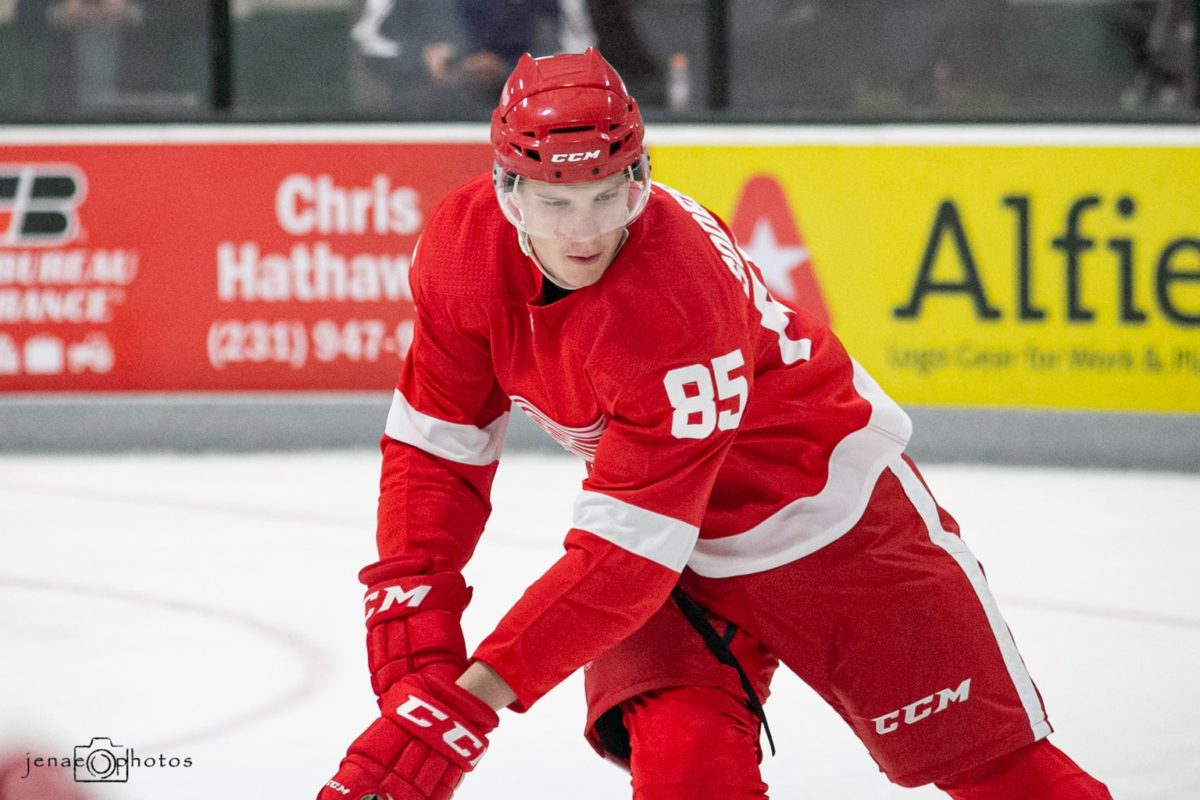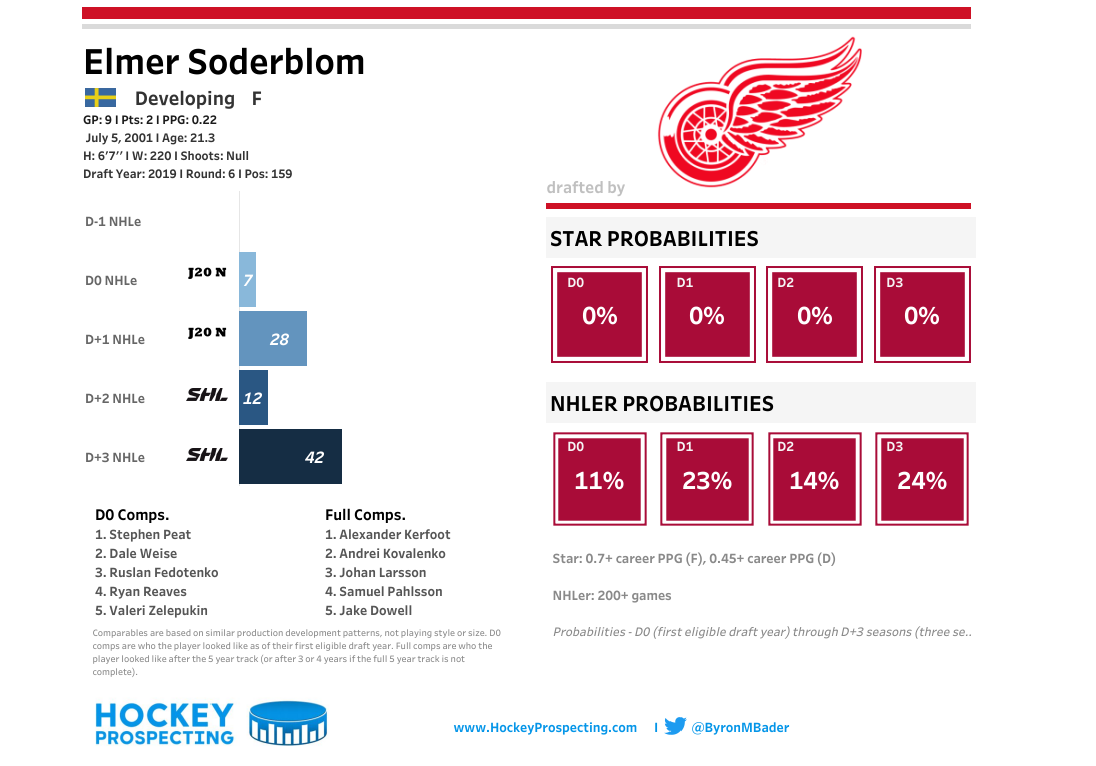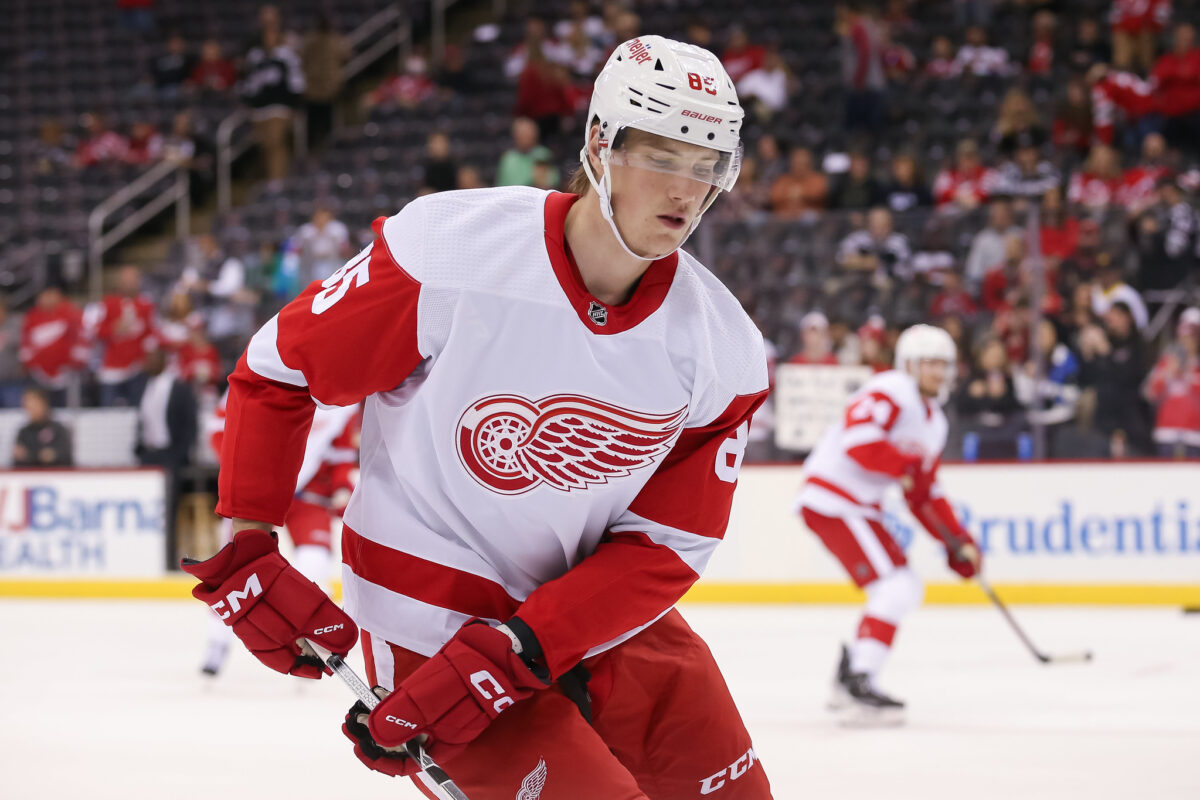Elmer Soderblom has been a favorite of prospect gurus who follow the Detroit Red Wings closely. He has a fantastic combination of monstrous size (6-foot-8, 249 pounds), skating, and magical hands in tight spaces. He’s swiftly become a fan favorite of Red Wings’ followers far and wide. There are some high hopes among the fan base too, but I believe we should temper our expectations of this young Swede this season.
Related: Detroit Red Wings’ Elmer Soderblom Is Ready For NHL Action
You always want the best for a prospect and for them to succeed and produce immediately in whatever league they play. In Soderblom’s case, did you know he has a track record of majorly increasing his production in the second year of whatever league he is playing in? He did it at the J20 level in Sweden as well as the Swedish Hockey League (SHL). Can he do it in the NHL next season? We will just have to wait and see.
A Little Bit About Breakout Threshold
As a way to attempt to predict when young players would start producing at a high level in the NHL, Breakout Threshold (BT) was born. BT is simply the point of a player’s career where they experience the highest jump in points. It’s typically a 24 percent increase from the previous year. As written here the BT is different for average-sized players and those who are smaller or larger than the “average” range.
Average-sized players are defined as being between 5-foot-10 and 6-foot-2, and weighing between 171 and 214 pounds. The data shows us that about 80 percent of players in that average size range take 200 games in the NHL to figure out who they are as players and reach that BT in production. For players on either side of that range? 400 games.

Given that logic, it is reasonable to expect that Soderblom will achieve his statistical breakout at or around the 400 games played mark. According to BT theory, about 80 percent of players follow typical BT, and 20 percent do not. About 20 percent either never hit their BT and leave the league (i.e Nail Yakupov) or have incredible production right away (i.e Connor McDavid). I believe he will be in the latter part of the 20 percent.
Soderblom has not developed like a typical prospect. His pattern of progression has been one poor year followed by one great year. It’s also worth highlighting that he’s changed leagues every two years as well. In his first year, he acclimates to the quality of competition and expectations, and then in the second year, he meets those expectations.
Soderblom’s J20 Swedish League Production
In Soderblom’s first year in the J20, he accrued 17 points in 44 games. J20 is a junior-level league in Sweden, so the quality of competition is more along the lines of the Ontario Hockey League or Western Hockey League than the SHL or Kontinental Hockey League. For a prospect to be successful in the NHL, their best chance is to dominate their peers when they play against them.

Seventeen points in 44 games put Soderblom at a 0.38 points per game pace (PPG). In his second year of J20, he increased his production to 55 points in 36 games. That’s a PPG pace of 1.52! He quadrupled his point pace in just one season. That type of production is what you want from a prospect playing in a junior league.
Soderblom’s SHL Production
Year one in the SHL and Soderblom collected five points in 28 games which works out to a 0.17 PPG pace. Again, that isn’t an impressive rate of production. This was his draft-plus-two-year (D+2), and you want to see an improvement on the previous year instead of a regression. Continued improvement year after year is the best predictor of eventual success at the NHL level.

Ruslan Fedotenko (0.42 PPG) and Andrei Kovalenko (0.61 PPG) were the most productive NHLers of the comparables listed in the above chart. If he lands in between the two at a 0.5 PPG player, that’s a win considering he was a sixth-round pick.
Year two of SHL action for Soderblom resulted in 33 points in 52 games (0.63PPG), nearly quadrupling (3.7 times) his point pace from the previous season. Now, this is establishing a pattern of behavior. Two times in Soderblom’s career he has quadrupled or nearly quadrupled his point pace from his first year to his second year in that league.
Is The NHL Next for Soderblom?
Soderblom has earned the trust of the Red Wings coaches by keeping him up in the NHL to start the season. However, 11 games in and he is only sitting at two points. That works out to a 0.18 PPG pace and only 15 total points over an 82-game schedule. That’s almost the exact PPG pace he had in his first SHL season (0.17PPG).
Related: Red Wings’ Prospect Report Kasper & Wallinder Shining Early
A three-and-a-half times increase in production would produce a 0.63 PPG pace for Soderblom, working out to 51 points in 82 games. This is my prediction for his point production next season. If he achieves this it would be a massive win for the Red Wings, their fans, and Soderblom himself.
Soderblom’s Impending Breakout
Soderblom has incredible tools that will make him a fantastic player in the NHL for a long time. Combine those tools with continued improvement of on-ice play – even in preseason play – and this breakout next season is inevitable.

The goal for Soderblom is to acclimatize to the NHL this season. Both the Grand Rapids Griffins and Red Wings coaching staff want him to focus on playing his game. Griffins’ head coach Ben Simon said, “There is an acclimation period, the shorter that acclimation can be to get comfortable in North America, I think the quicker he’s gonna have success.”
I believe that Soderblom’s history of quadrupled production every second season will repeat itself. Look for a 50-point season if he plays 82 games, and a 0.63 PPG pace, regardless of games played. Look for him to break out in the NHL…next year.